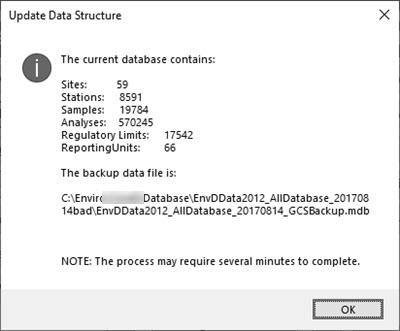Why weren’t all of my tables converted when I upgraded to Enviro Data Version 8?
An Enviro Data database contains a complex set of tables each with specific structures and requirements for their fields. In order to protect the data integrity, in Version 8 we have not only added some new tables and fields, but also increased referential integrity and also checking of your data during the upgrade.
Before starting, if you are trying to upgrade an old table that you have not used in a while and are not sure what version it is in, you need to determine that first. You can do that by opening the database in Access or Enviro Data, clicking the F11 key which opens the table listing and then opening the Versions table. The table's version number should be shown in the first record. An Enviro Data 2012 table can be updated simply by attaching to it in the EDITOR and following the prompts. Databases used with version 2010 will need to be converted using version 2012 before upgrading to Version 8.
If your database is older than Version 2010, please contact
To ensure that everything is converted correctly into Version 8, Enviro Data displays an Update Structure Summary showing the number of records in the main tables both before and after the conversion. The example below shows the main tables before being converted. (Note other tables are also being updated in the process but only the main ones are shown.)

If the structure in one or more of these tables violates data integrity, possibly because it had been modified, or some other problem, this will cause the conversion to be flawed but the resulting database will still be attached to the Editor. When this happens, you will see in the form shown below that one or more “Converted” tables will not contain the same number of records that the “Initial Record Count” showed.
YOU MUST PAY CLOSE ATTENTION TO THE UPDATE STRUCTURE SUMMARY FORM TO MAKE SURE YOUR DATA WAS CORRECTLY CONVERTED.

In the above case, an extra field had been added to the Analyses table by the client. Additionally, the RegLimitType table contained some records with descriptions that were not unique.
The issue we encounter the most when upgrading a database to the Ver. 8 format is where a client has modified one or more of the tables in Enviro Data by adding additional fields. In the case above, the extra field in the Analyses table was simply deleted.
A more difficult issue to find is a problem in a lookup table. If a lookup table fails to convert you will not see it listed but this problem may prevent a related table to not convert along with other tables dependent on it. Most lookup tables contain a field for both a code and for the code’s description and all descriptions must be unique in Version 8. This was notrequired in Ver. 2012. One example of this is where the RegUnit in the RegLimits table has a code for a unit that does not exist in the ReportingUnits table. This can require creating a query with the relationship between the table in question and the appropriate lookup table.
So far, the other most common problem of this type has been in the RegLimitTypes table where limits were imported from a spreadsheet with a RegType longer than the 50 characters that this field holds. This means the RegType (the description), is truncated and may be identical to another one for a different reg. limit.
The easiest way to find these is to open the table in question, sort the description field alphabetically and look for long descriptions that match. The fix is to abbreviate them to 50 or fewer characters so they are unique. In the example below (from the same database as above) the Reg. Limits had been imported with some of their descriptions longer than 50 characters. When these were truncated, they became identical. See below, and how they were corrected.


This fix also applies to other lookup fields where the descriptions may not be unique. The issue is figuring out which tables to check. You can get a clue of which lookups to check based on which of main table (starting with Sites) that did not convert correctly. For example, if the Stations table had a problem, check the lookups shown under Stations using Manage Lookups in the Editor. In the example above, you probably don’t have to check every Station lookup, only those in the “Show Less” tab of the form.
 View each lookup in Datasheet view sort the description field and look for identical values and correct any you find. Then move on to the next lookup table for the appropriate table. If you can’t find the problem there, you can click Show More and check more of the Stations lookups.
View each lookup in Datasheet view sort the description field and look for identical values and correct any you find. Then move on to the next lookup table for the appropriate table. If you can’t find the problem there, you can click Show More and check more of the Stations lookups.
After a successful upgrade, we recommend moving the new Version 8 database into the C:\Enviro\EData8 folder if you are working on a local copy.
When you start the conversion process the source database is copied with “_GCSBackup” appended to the file name. Additionally, the source database is not touched at all, so you have two backup copies.
If after reviewing the above you still need asistance, contact
